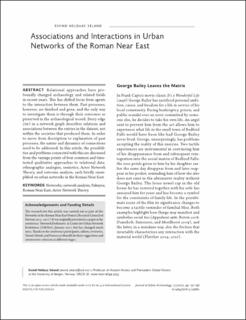| dc.contributor.author | Seland, Eivind Heldaas | |
| dc.date.accessioned | 2021-08-09T12:49:13Z | |
| dc.date.available | 2021-08-09T12:49:13Z | |
| dc.date.created | 2021-04-19T15:29:24Z | |
| dc.date.issued | 2021 | |
| dc.identifier.issn | 2736-2426 | |
| dc.identifier.uri | https://hdl.handle.net/11250/2767046 | |
| dc.description.abstract | Relational approaches have profoundly changed archaeology and related fields in recent years. This has shifted focus from agents to the interaction between them. Past processes, however, are finished and gone, and the only way to investigate them is through their outcomes as preserved in the archaeological record. Every edge (tie) in a network graph describes relations and associations between the entries in the dataset, not within the societies that produced them. In order to move from description to explanation of past processes, the nature and dynamics of connections need to be addressed. In this article, the possibilities and problems connected with this are discussed from the vantage points of four common and timetested qualitative approaches to relational data: ethnographic analogies, semiotics, Actor Network Theory, and outcome analysis, each briefly exemplified on urban networks in the Roman Near East. | en_US |
| dc.language.iso | eng | en_US |
| dc.relation.haspart | Journal of Urban Archaeology. 2021, 3, 131-136. | en_US |
| dc.rights | Navngivelse-Ikkekommersiell 4.0 Internasjonal | * |
| dc.rights.uri | http://creativecommons.org/licenses/by-nc/4.0/deed.no | * |
| dc.title | Associations and Interactions in Urban Networks of the Roman Near East | en_US |
| dc.type | Journal article | en_US |
| dc.type | Peer reviewed | en_US |
| dc.description.version | publishedVersion | en_US |
| dc.rights.holder | Copyright 2021 Brepols Publishers | en_US |
| cristin.ispublished | true | |
| cristin.fulltext | original | |
| cristin.qualitycode | 1 | |
| dc.identifier.doi | 10.1484/J.JUA.5.123680 | |
| dc.identifier.cristin | 1905130 | |
| dc.source.journal | Journal of Urban Archaeology (JUA) | en_US |
| dc.source.pagenumber | 131-136 | en_US |
| dc.identifier.citation | Brepols Publishers | en_US |
| dc.source.volume | 3 | en_US |

